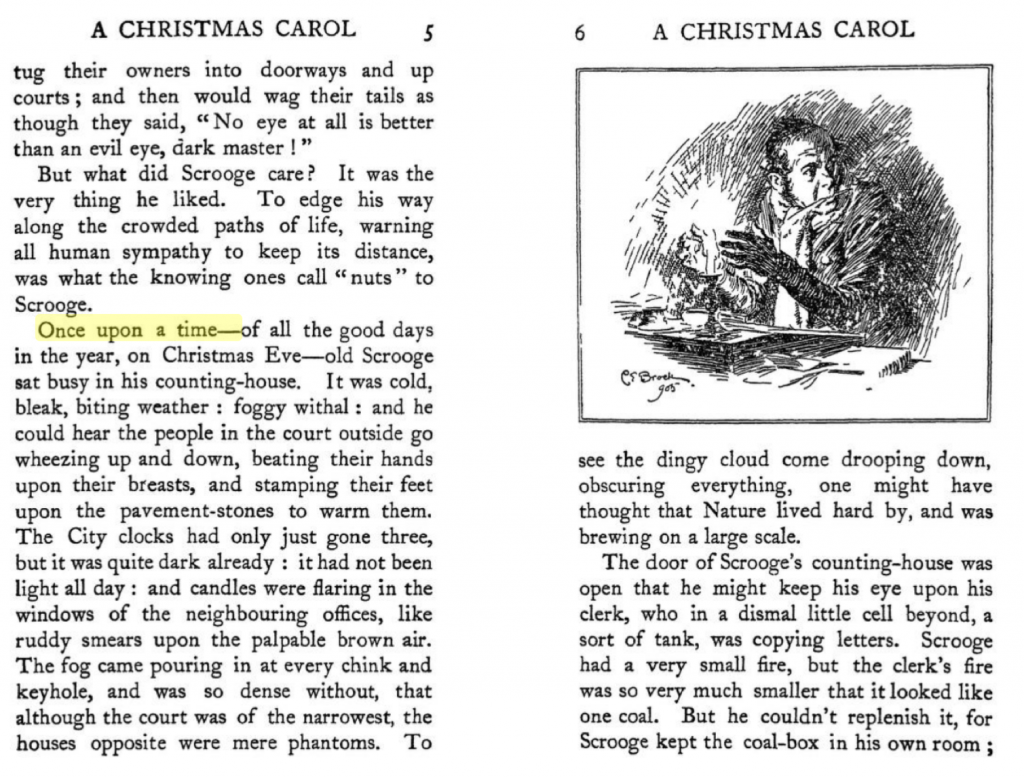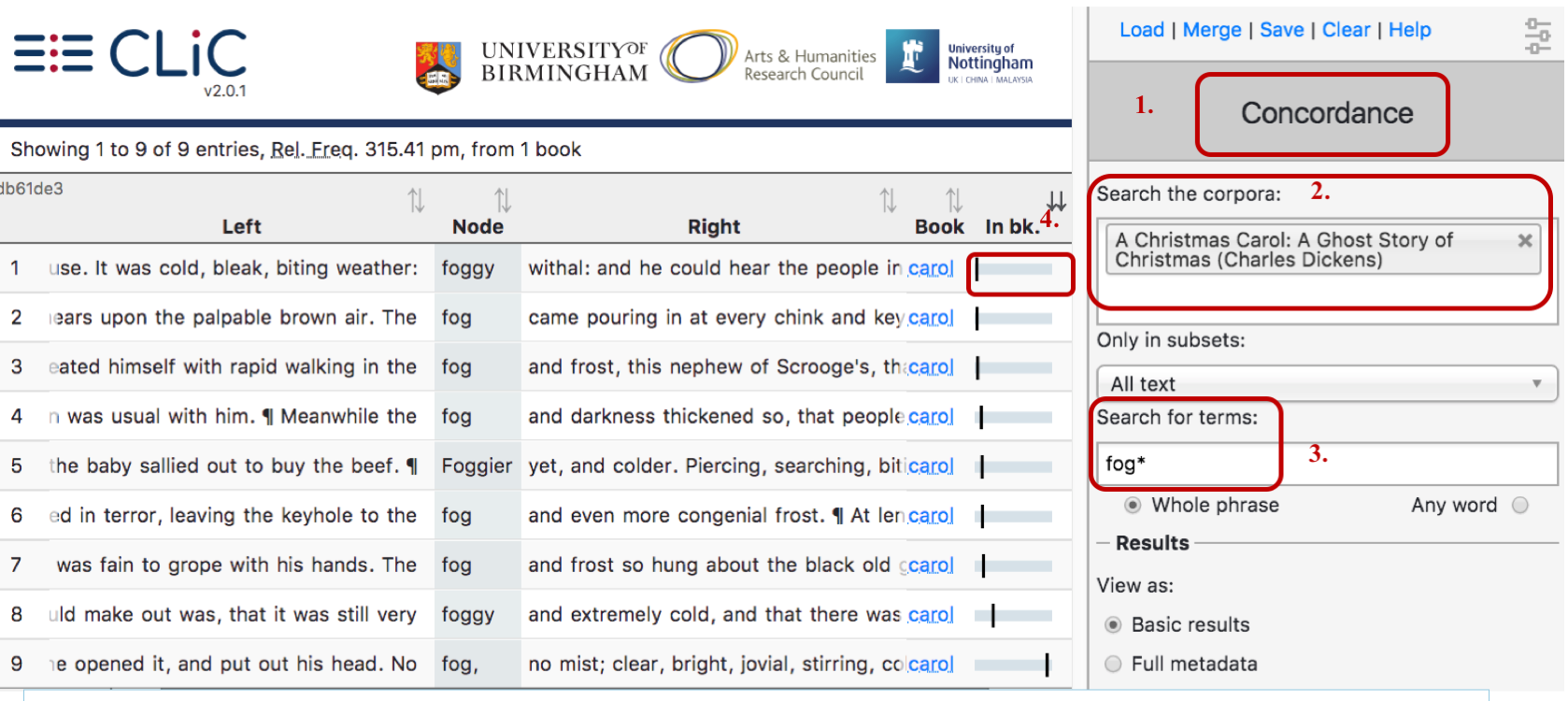A Christmas Carol is a popular text choice for students in GCSE English Literature Section B (see the AQA Lead Examiner’s Report 2017). No wonder then, that it is also one of the top texts in our CLiC 2.0 web app for which teachers request activities. In fact, two teachers have previously written guest blog posts about this text for us: Kat Howard explores the representation of time in A Christmas Carol and Lorraine Adriano reports on the investigation of the notorious “Bah, humbug!” by her year 8 students.
A Christmas Carol was also the main focus of the workshop that we had the pleasure of running yesterday for a group of year 10 students from the University of Birmingham School. In the following, we outline some of the activities we did with the group. If you want to use the activities or adapt them for your own teaching, you can download the worksheet below.
Links between structure of the text and the theme of redemption in A Christmas Carol

For Dickens, as for most authors, the beginning of the story is very important. In A Christmas Carol, the reform that Scrooge undergoes, his “redemption” is a key theme. The novella starts by introducing the circumstances of Scrooge and his business partner Marley. A few pages into the novella, we encounter the beginning of the ghost story itself, signalled by once upon a time.
The opening paragraph of this story is filled with words that create a bleak and cold atmosphere, foreshadowing the appearance of the ghosts. This effect is created through the use of contrast (dark vs. light) and personification (the fog came pouring in, to see the dingy cloud come drooping down):
Once upon a time–of all the good days in the year,
on Christmas Eve–old Scrooge sat busy in his
counting-house. It was cold, bleak, biting weather: foggy
withal: and he could hear the people in the court outside,
go wheezing up and down, beating their hands
upon their breasts, and stamping their feet upon the
pavement stones to warm them. The city clocks had
only just gone three, but it was quite dark already—
it had not been light all day–and candles were flaring
in the windows of the neighbouring offices, like
ruddy smears upon the palpable brown air. The fog
came pouring in at every chink and keyhole, and was
so dense without, that although the court was of the
narrowest, the houses opposite were mere phantoms.
To see the dingy cloud come drooping down, obscuring
everything, one might have thought that Nature
lived hard by, and was brewing on a large scale.
(A Christmas Carol, Stave 1, paragraph 10)
This opening paragraph has the potential of giving students key quotations that can be useful when they’re revising A Christmas Carol. It is important that students don’t only learn quotations in isolation, but are able to make connections to the themes and the development of the text.
Using CLiC to explore the links
With CLiC, we can now check how this passage links to the rest of the novella. One option is to search for all occurrences of fog and its adjective forms. The output of this search will give a “concordance” (essentially a table that displays all occurrences of a word, phrase or pattern in a text or set of texts). To do so, students simply follow these steps:
- Open the CLiC website in the Chrome, Firefox or Safari browser (clic.bham.ac.uk).
- Click on the “Concordance” tab.
- Under “Search the corpora”, select “A Christmas Carol: A Ghost Story of Christmas (Charles Dickens)” – a fast option to select it is to start typing “Carol” and the title will be recommended.
- Under “Search for terms”, enter “fog*” (the * is a “wildcard”, a placeholder for extra letters, so you will find words like foggy).
- For each concordance line, click on the slider to see the “in bk.” (“in book”) view. Check the context for each occurrence: how is “fog” used here?
- Describe the development that the different occurrences indicate from the beginning to the end of the novella.

Through step 4, clicking on the slider in the “in book” column, we are taken to a view of the examples in the context of the staves. Looking more closely at the first occurrence, “foggy”, in Stave I of the novella, we see how it contributes to creating a bleak atmosphere, foreshadowing the appearance of the ghosts. This finding can be more contextualised when linking it to the final use, “no fog”. The concordance shows that this last occurrence immediately stands out as different from the preceding ones: it is the only one that is negated. Not only is the fog gone by this point, but the context of this occurrence contains much more positive adjectives (“clear”, “bright”, “jovial”, “glorious”, etc.) than found in the context of the first occurrence (“bleak, “biting”).
Starting with the concordance, it is possible to track the usage of word forms across the text to explore the structure and identify important quotations. Going through this process will allow students to not only study the quotations that include “foggy” and “fog” from the beginning and end of A Christmas Carol, but also to understand how they link to the plot and the development of the story. The change that takes place in Scrooge is mirrored by the description of the change in the weather, and in particular the disappearance of the fog.
(Photography by Victoria Beddoes)
The year 10 students in this workshop were really engaged and participated well. All of them saw and used CLiC for the first time in this session, but quickly understood how it works. Their feedback shows that they enjoyed working with a digital tool for their English Literature revision:
- “I liked being able to use interactive software because it’s something different to how we normally revise”
- “Learning about the cool new resource that we discovered. It was easy to use and very fast and helpful when searching for quotes”
- “Learning about how words can represent certain feelings or characteristics within a book / story”
As part of the workshop, students also had the chance to get started on their group submissions for our Digital Reading Competition. The aim of the competition is to encourage students to explore literature using CLiC by coming up with their own little questions. Students will analyse a text and theme of their choice. They record their search procedures in order to write them up as a short activity for other students to follow. This is a great chance for students to work in a team and carry out an independent text analysis, for example to practise for the NEA! Students will work in teams for the chance to win Amazon vouchers, and the best activities will also be published on our Blog and in the second edition of the CLiC Activity Book.
Resources to download
The workshop shows students the importance of the textual structure for the development of themes and characters. In Dickens’s works in particular, the description of the physical world is a key aspect of creating the atmosphere of where stories unfold and how the novels deal with social issues.
In the workshop we also compared the passage from the beginning of A Christmas Carol with the beginnings of Bleak House and Great Expectations, where similar techniques are used to create a dark and mysterious atmosphere. In Bleak House, the similarity can obviously be found in the famous repetition of “fog” at the beginning, as you can see from the distribution of the word across the novel:

In Great Expectations, the atmosphere is created through different, but similar types of descriptions of the environment of the graveyard and the marsh country. If you would like to try out and/or adapt the activities from our workshop, you can download the handout here:
- Exploring structure and themes in a Christmas Carol with CLiC
Further ideas for using CLiC in the classroom can be found in our free Activity Book (available as PDF and Word document) and in the guest posts that teachers have written for us. What are your thoughts on these activities? Are there any specific texts or topics that you would like to use CLiC for? Let us know in the comments below or drop us an email or direct message on Twitter. If you’re interested in writing a guest post, have a look at our guidelines and get in touch! Finally, the deadline for our Digital Reading Competition is coming up – if you have any students that might be interested in participating, do check out the competition website and let us know if you have any questions.
Please cite this post as follows: Mahlberg, M. & Wiegand, V. (2019) Finding links between the structure and themes of A Christmas Carol [Blog post]. CLiC Fiction Blog, University of Birmingham. Retrieved from https://blog.bham.ac.uk/clic-dickens/2019/05/17/finding-links-between-the-structure-and-themes-of-a-christmas-carol/








Join the discussion
1 people are already talking about this, why not let us know what you think?Comments